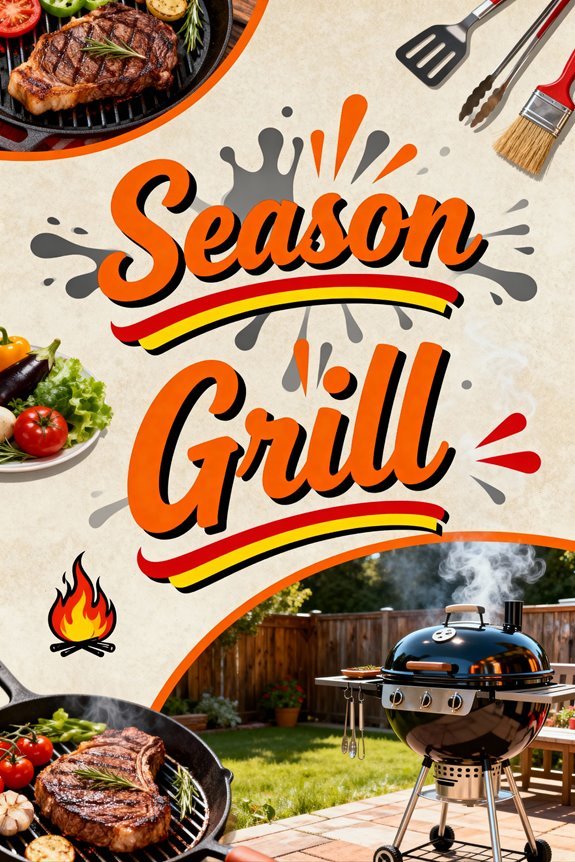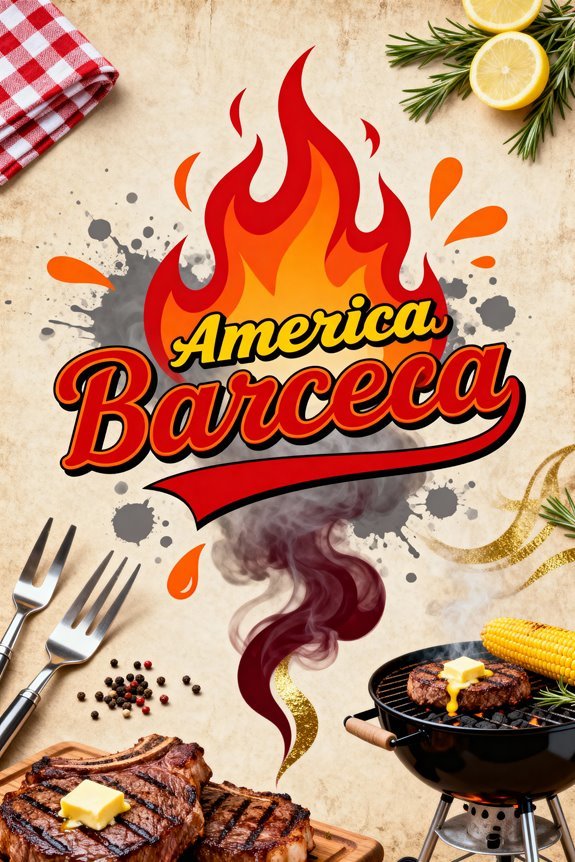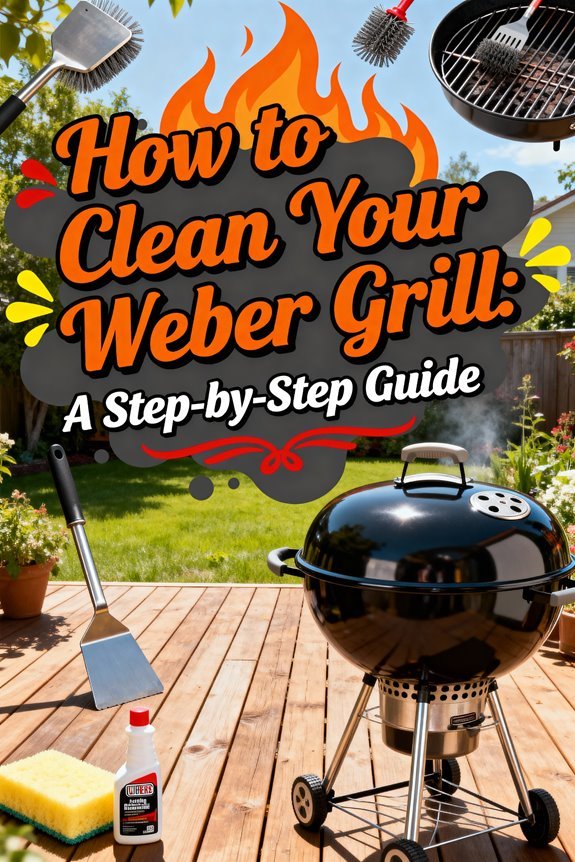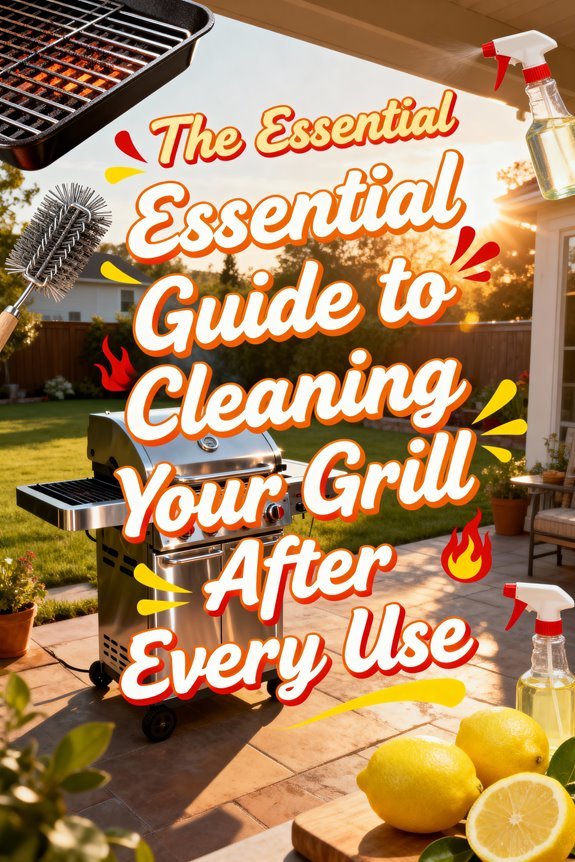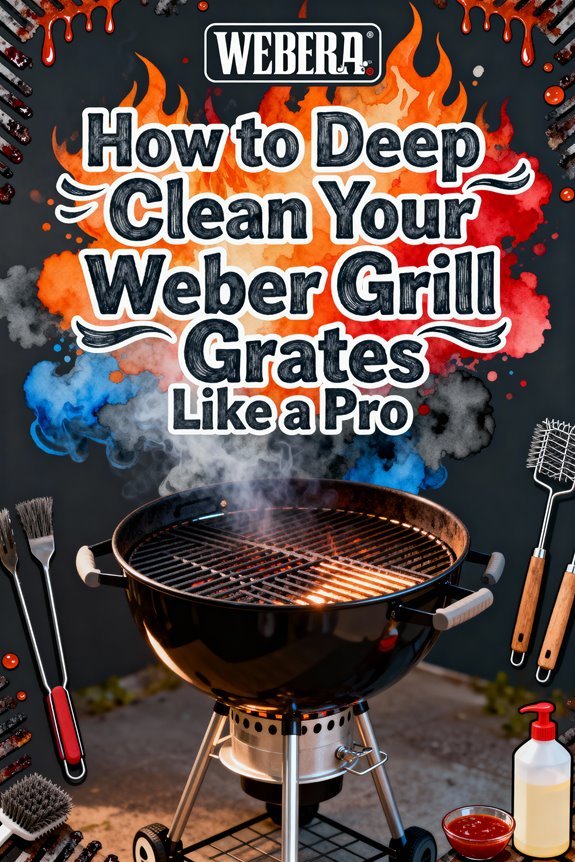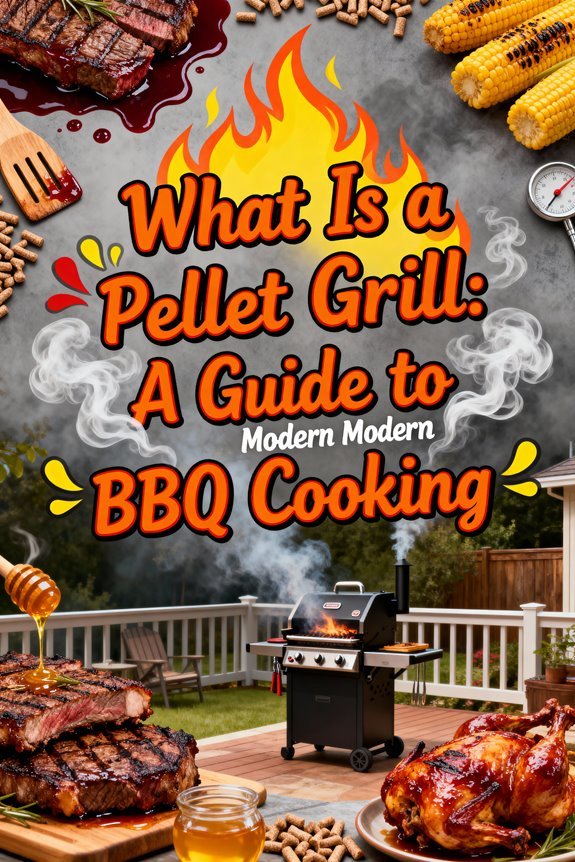To clean your flat top grill professionally, let it cool 10-15 minutes, then scrape debris toward the grease chute using a metal scraper at 45 degrees. Heat the surface to 300-350°F and apply a vinegar-water solution or baking soda paste. Scrub with a grill brick using overlapping strokes, then wipe toward the grease trap. For rust, use steel wool with baking soda paste, then season with high smoke-point oil applied in thin layers. This guide covers advanced techniques for best performance.
Preparing Your Grill for Cleaning
Proper preparation prevents ineffective cleaning and potential safety hazards when maintaining your flat top grill. Begin by implementing essential safety precautions: turn off all knobs, close the propane valve, and allow 10–15 minutes for complete cooling. Never apply cleaning solutions to hot surfaces, as this creates dangerous steam and chemical reactions. Similar to safe food handling, cleaning should occur promptly after cooking to prevent residue from hardening. Just as thick vegetable slices prevent food from falling through grill grates, proper cleaning tools prevent surface damage.
Remove loose food debris immediately using a metal scraper, directing particles into the grease chute. Empty the grease catch or tray after every use to prevent fire hazards and overflow. Conduct a thorough grill inspection by heating to medium for 10 minutes, which loosens stuck-on residue. Identify areas with rust, carbonized buildup, or blockages requiring extra attention. Clear your workspace, guarantee adequate ventilation, and position all cleaning tools within reach before proceeding. Gather essential supplies including a Traeger Flatrock grill scraper, clean cloth or paper towels, tongs, and seasoning oil or canola oil for post-cleaning conditioning.
[affiai keyword=”flat top grill cleaning supplies” template=”carousel” count=”3″
Essential Tools and Supplies You’ll Need
Success in flat top grill maintenance depends on assembling the right arsenal of specialized cleaning equipment before you begin. You’ll need stainless steel scrapers with angled blades and replacement components for heavy-duty residue removal. Grill bricks or pumice stones handle rust and baked-on debris without scratching surfaces. Professional-grade scouring pads and high-temperature brushes provide final polishing after initial scraping. For chemical cleaning, select non-caustic degreasers like Stera-Sheen or Blackstone formulas that dissolve carbon buildup while preserving seasoning. These best cleaning products maintain ideal heat distribution by eliminating oil residue. Similar to proper fish storage, daily inspection for signs of residue buildup helps prevent contamination and ensures optimal cooking surfaces. Like the low and slow smoking process used for country-style ribs, taking your time with cleaning ensures the best results. Complete your kit with microfiber cloths for post-cleaning surface conditioning. A comprehensive griddle cleaning kit typically includes multiple tools such as scrapers, cleaning blocks, scouring pads, and brushes that work together to handle both light maintenance and tough cleaning tasks. Essential accessories include multifunction scrapers combining various cleaning angles and handle-mounted pad systems that reduce operator fatigue during extended cleaning cycles.
Scraping Away Food Debris and Grease
Effective debris removal begins the moment you finish cooking—while your flat top grill maintains a warm surface temperature between 300-350°F. This ideal heat range softens grease and carbonized particles, making immediate scraping greatly more efficient than cold-surface cleaning.
Use a heavy-duty metal scraper at a 45-degree angle, applying moderate pressure to avoid surface damage. Similar to how medium-high heat grilling produces the juiciest burgers, this temperature range ensures optimal cleaning results. Just like grill brush techniques help maintain traditional BBQ grates, systematic scraping is essential for flat tops. Execute multiple passes, pushing debris toward a collection point for quick disposal. For corners and edges, switch to a smaller angled scraper.
Proper scraping techniques include using tools like the Scotch-Brite™ Squeegee 410 to sweep away loosened residues. Always wear heat-resistant gloves and dispose of collected debris immediately to prevent fire hazards. Understanding your griddle’s material composition—whether steel, cast iron, ceramic glass, or chromium—helps you select appropriate scraper types that won’t damage the surface. This systematic approach reduces cleaning time to under five minutes while preventing hardened buildup.
[affiai keyword=”flat top grill scraper and cleaning tools” template=”carousel” count=”3″
Deep Degreasing Your Cooking Surface
Regular flat top grill maintenance requires deep degreasing every 1-2 weeks depending on usage volume, preventing carbonized oil buildup that compromises food quality and surface integrity. Heat your griddle to medium for 10–15 minutes while wearing heat-resistant gloves. Apply vinegar-water solution (1:1 ratio) or baking soda paste directly onto the warm surface, letting it sit 1–2 minutes to penetrate grease. Scrub with a griddle brick using firm, overlapping strokes, then wipe residue toward the grease trap. Rinse thoroughly with minimal water—excess moisture causes rust on cast iron surfaces. For stainless steel, use a damp cloth for final removal of cleaning agents. Microfiber towels effectively capture dirt particles and grease residue during the final wipe-down phase. For stubborn rust spots, vinegar soaking can effectively dissolve oxidation before proceeding with the regular cleaning process. As an alternative to commercial cleaning tools, aluminum foil balls provide a safe and effective scrubbing method that won’t damage your cooking surface. Proper cleaning frequency protects your investment and prepares surfaces for seasoning techniques that maintain non-stick properties.
Removing Rust and Stubborn Buildup
When rust appears on your flat top grill, immediate action prevents permanent surface damage and maintains ideal cooking performance. Heat the griddle on medium-high for 20 minutes to loosen oxidized particles, then scrape thoroughly with metal spatulas or grill stones. Use abrasive tools like steel wool pads or medium-grit sandpaper in circular motions to eliminate stubborn buildup across the entire cooking surface, including sides and corners. Baking soda paste provides a gentle yet effective natural rust-removing solution. Using a non-abrasive cloth for regular cleaning helps prevent rust formation and preserves the grill’s surface.
For severe rust, apply equal parts vinegar and water to soften corrosion before scrubbing. Follow chemical treatments with aggressive physical cleaning to clear all residues. After rust removal, wipe the surface clean and apply multiple thin coats of cooking oil to re-season the steel. Spread 4-5 tablespoons of oil evenly across the surface before scrubbing with your chosen abrasive tool. Proper rust prevention requires consistent oiling after each use and storing your grill in dry, well-ventilated conditions.
Seasoning Your Flat Top Grill Properly
Proper seasoning transforms your flat top grill‘s bare metal surface into a durable, non-stick cooking platform through oil polymerization—a chemical bonding process that creates protective layers resistant to corrosion and food adhesion.
Paper towel application ensures the most even distribution of oil during the seasoning process. Execute these seasoning techniques: preheat your cleaned griddle to 300–350°F for 10–15 minutes. Oil selection matters—choose high smoke-point options like canola, flaxseed, or avocado oil. Apply 2–3 tablespoons in a zigzag pattern, spreading thinly with tongs and cloth to prevent pooling. Heat until smoking occurs, signaling polymerization. Allow smoke to subside completely before repeating. Complete 3–5 cycles on new equipment, building multiple protective coats. Each application darkens the surface, enhancing non-stick performance. After final treatment, cool completely for 30 minutes. Regular maintenance helps prevent rust and food buildup that could damage your seasoned surface. Re-season periodically following heavy use or visible wear. For optimal results, re-season during cleaning to maintain the griddle’s nonstick qualities and ensure consistent cooking performance.
[affiai keyword=”high smoke point oils for griddle seasoning” template=”carousel” count=”3″
Cleaning the Exterior and Burner Components
While a well-seasoned cooking surface handles food contact, your flat top grill’s exterior and burner components demand equal maintenance attention to guarantee longevity and safe operation. For exterior cleaning, apply grease-cutting wipes or mild dish soap with microfiber cloths once the unit’s completely cool. Remove detachable shelves and trays, wipe thoroughly, rinse residue, then dry to prevent streaking and corrosion. Similar to indoor grills, nonmetallic pads work best for stubborn residue without damaging surfaces. Using a heat-resistant sponge at 400°F helps effectively remove tough grime without scratching surfaces.
Burner maintenance requires disconnecting the propane supply first. Remove grates and covers, then clear burner ports with wire brushes or pipe cleaners to eliminate blockages from grease, debris, or spider webs. Inspect for rust or damage, replacing compromised components immediately. Address exterior rust spots using steel wool with vinegar, then apply high-smoke-point oil for protection. Empty grease trays frequently, cleaning with stiff brushes to prevent fire hazards and maintain peak functionality. Periodically clean the burners to ensure consistent heat distribution and optimal grill performance.
[affiai keyword=”grill burner cleaning tools and supplies” template=”carousel” count=”3″
Maintaining Your Grill Between Deep Cleans
Between major cleaning sessions, your flat top grill requires consistent daily maintenance protocols to sustain operational efficiency and extend equipment lifespan. Execute shift-ending scrapes while the surface remains warm, removing all debris and grease accumulation. Direct waste into grease chutes and inspect traps daily to prevent overflow hazards. Apply a thin layer of high-smoke-point oil after each cleaning session, heating until it smokes to maintain seasoning integrity. Regular inspections should identify surface warping, thermostat malfunctions, or burner irregularities before they escalate into operational failures. Between cooking cycles, perform light cleanings with non-abrasive tools to preserve flavor integrity and prevent carbon buildup. For optimal safety during cleaning, always use protective grill mitts to avoid burns when handling hot surfaces. Schedule comprehensive weekly deep cleans with a completely cooled griddle to address buildup that daily maintenance cannot eliminate. Much like maintaining low and slow temperatures for smoking chicken quarters, this disciplined approach to daily maintenance minimizes downtime, reduces repair costs, and guarantees consistent heat distribution across your cooking surface.
Proper Storage to Prevent Damage
After completing your final maintenance cycle, strategic storage protocols become critical for preserving your flat top grill’s structural integrity and cooking performance. Your storage location must maintain low humidity levels and stable temperatures to prevent thermal shock and corrosion. Apply protective coatings—specifically food-grade oil or maintain existing seasoning layers—to create a moisture barrier against rust formation. Guarantee complete dryness before storage, as any residual moisture accelerates oxidation processes. Stiff brushes are essential tools for removing debris before storage, just as they are during regular cleaning maintenance.
Similar to how stable temperatures around 300°F are crucial for smoking meats, maintaining consistent environmental conditions during storage is essential for grill longevity. Utilize griddle-specific storage bags or soft covers to shield surfaces from environmental contaminants and physical damage. In colder climates, provide additional insulation against freezing conditions. Position your grill away from direct sunlight and precipitation sources. Implement regular inspection intervals to identify early-stage rust development, enabling prompt remediation before permanent damage occurs. Monthly inspections are particularly important when storing your grill for extended periods to catch any moisture-related issues early.
[affiai keyword=”flat top grill storage covers protective” template=”carousel” count=”3″


